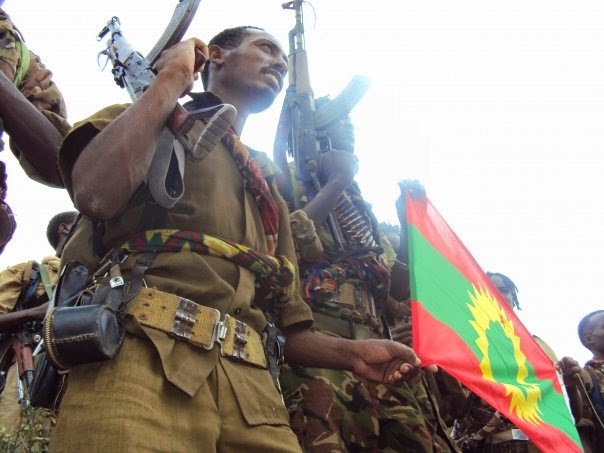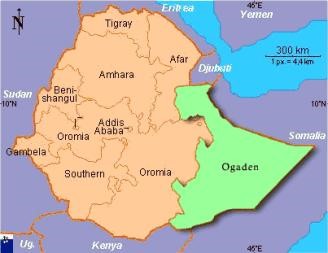Andrew McGregor
March 3, 2011
Political reverberations from the revolutions in Tunisia and Egypt continue to sweep through the Horn of Africa, which has already witnessed demonstrations against the Transitional Federal Government and its Islamist opponents in Somalia (see Terrorism Monitor Briefs, February 17). Now militants belonging to Ethiopia’s Oromo Liberation Front (OLF) have called for all of Ethiopia’s ethnic and religious groups to emulate the Tunisian and Egyptian revolts and unite in deposing the Tigrayan-dominated government of Prime Minister Meles Zenawi, leader of the Tigrayan People’s Liberation Front, the major element of the ruling Ethiopian People’s Revolutionary Democratic Front (EPRDF) coalition.
 Rebels of the Oromo Liberation Front
Rebels of the Oromo Liberation Front
In a statement broadcast in both Afan Oromo and Amharic, the OLF maintained that only a revolution in the streets could command the attention of the West: “Until [Addis Ababa] becomes the next Tunis or Cairo, their ears will not listen,” though “most of the superpower countries, the hitherto supporters and handlers of the tyrannical regimes, were forced to quickly abandon their darlings and side with the people in revolt.” Most importantly, the Oromo must unite with Ethiopia’s Amharic speakers to provide a long-term solution to the country’s ills (Jimma Times, February 27).
The Oromo are the largest single ethnic group in Ethiopia and dwell principally in central and southern Ethiopia, though there is a high degree of social integration with Ethiopia’s Amharic-speaking peoples, the traditional rulers of the nation until 1991. The Oromo are religiously diverse, with members of the ethnic group following Islam, Christianity and traditional religions, but not all Oromo opposition leaders and parties agree on the necessity of a revolution.
In recent days, a joint operation along the border by Ethiopian and Kenyan military forces that began last November is reported to have resulted in the arrest of at least 120 OLF fighters and the seizure of a quantity of arms, grenades and missiles. The existence of a cross-border Oromo community is reported to have complicated efforts to identify OLF members; according to a local Kenyan provincial commissioner, “These people speak the local dialect and it may be hard to distinguish them from the locals but the locals themselves are volunteering information that will lead to their arrest.” The operation will continue to search for other OLF members (Sudan Tribune, February 26).
The OLF began an armed struggle for Oromo self-determination and local autonomy from the Amhara monarchy in 1973. After dropping out of the coalition government formed after the conclusion of the Ethiopian civil war and the fall of the communist Derg regime of Mengistu Haile Mariam in 1991, the OLF then took up arms against the new Tigrayan-dominated government. Addis Ababa classifies the OLF as a terrorist organization and has accused it of being responsible for a series of bombings in Addis Ababa in 2008, a claim denied by the OLF (see the OLF statement published in the Sudan Tribune, May 29, 2008).
Despite assertions by Ethiopian authorities that the military capabilities of the OLF and its armed wing, the Oromo Liberation Army (OLA), have been much diminished by constant pressure from government security services, the movement recently claimed that a special unit of the OLA operating in the OLF’s so-called “Eastern Zone” raided and destroyed a government military base in Kombolcha, killing 19 soldiers and injuring 25 others (Voice of Oromo Liberation Radio, February 25; OLF News, February 26; for OLF military capabilities, see Militant Leadership Monitor Briefs, January 29, 2010). The attack and the alleged casualties have not been confirmed by government sources. Kombolcha is 12km from the commercial center of Harar. The OLA has also claimed responsibility for the February assassination of a government intelligence official in the Eastern Oromia district who was accused of harassing members of the local Oromo community. An OLA statement warned: “Those who continue to be part of the TPLF killing machine will face the same death penalty unless they refrain from such evil acts” (OLF News, February 6; Jimma Times, February 9).
This article first appeared in the March 3, 2011 issue of the Jamestown Foundation’s Terrorism Monitor

